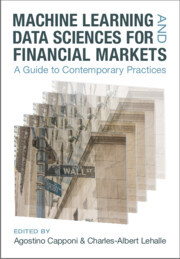Machine Learning and Data Sciences for Financial Markets A Guide to Contemporary Practices
Langue : Anglais
Coordonnateurs : Capponi Agostino, Lehalle Charles-Albert

Learn how cutting-edge AI and data science techniques are integrated in financial markets from leading experts in the industry.
Leveraging the research efforts of more than sixty experts in the area, this book reviews cutting-edge practices in machine learning for financial markets. Instead of seeing machine learning as a new field, the authors explore the connection between knowledge developed by quantitative finance over the past forty years and techniques generated by the current revolution driven by data sciences and artificial intelligence. The text is structured around three main areas: 'Interactions with investors and asset owners,' which covers robo-advisors and price formation; 'Risk intermediation,' which discusses derivative hedging, portfolio construction, and machine learning for dynamic optimization; and 'Connections with the real economy,' which explores nowcasting, alternative data, and ethics of algorithms. Accessible to a wide audience, this invaluable resource will allow practitioners to include machine learning driven techniques in their day-to-day quantitative practices, while students will build intuition and come to appreciate the technical tools and motivation for the theory.
Interacting with Investors and Asset Owners: Part I. Robo-advisors and Automated Recommendation: 1. Introduction to Part I. Robo-advising as a technological platform for optimization and recommendations; 2. New frontiers of robo-advising: consumption, saving, debt management, and taxes; 3. Robo-advising: less AI and more XAI? Augmenting algorithms with humans-in-the-loop; 4. Robo-advisory: from investing principles and algorithms to future developments; 5. Recommender systems for corporate bond trading; Part II. How Learned Flows Form Prices: 6. Introduction to Part II. Price impact: information revelation or self-fulfilling prophecies?; 7. Order flow and price formation; 8. Price formation and learning in equilibrium under asymmetric information; 9. Deciphering how investors' daily flows are forming prices; Towards Better Risk Intermediation: Part III. High Frequency Finance: 10. Introduction to Part III; 11. Reinforcement learning methods in algorithmic trading; 12. Stochastic approximation applied to optimal execution: learning by trading; 13. Reinforcement learning for algorithmic trading; Part IV. Advanced Optimization Techniques: 14. Introduction to Part IV. Advanced optimization techniques for banks and asset managers; 15. Harnessing quantitative finance by data-centric methods; 16. Asset pricing and investment with big data; 17. Portfolio construction using stratified models; Part V. New Frontiers for Stochastic Control in Finance: 18. Introduction to Part V. Machine learning and applied mathematics: a game of hide-and-seek?; 19. The curse of optimality, and how to break it?; 20. Deep learning for mean field games and mean field control with applications to finance; 21. Reinforcement learning for mean field games, with applications to economics; 22. Neural networks-based algorithms for stochastic control and PDEs in finance; 23. Generative adversarial networks: some analytical perspectives; Connections with the Real Economy: Part VI. Nowcasting with Alternative Data: 24. Introduction to Part VI. Nowcasting is coming; 25. Data preselection in machine learning methods: an application to macroeconomic nowcasting with Google search data; 26. Alternative data and ML for macro nowcasting; 27. Nowcasting corporate financials and consumer baskets with alternative data; 28. NLP in finance; 29. The exploitation of recurrent satellite imaging for the fine-scale observation of human activity; Part VII. Biases and Model Risks of Data-Driven Learning: 30. Introduction to Part VII. Towards the ideal mix between data and models; 31. Generative Pricing model complexity: the case for volatility-managed portfolios; 32. Bayesian deep fundamental factor models; 33. Black-box model risk in finance; Index.
Agostino Capponi is Associate Professor in the Department of Industrial Engineering and Operations Research at Columbia University. He conducts research in financial technology and market microstructure. His work has been recognized with the NSF CAREER Award, and a JP Morgan AI Research award. Capponi is a co-editor of Management Science and Mathematics and Financial Economics. He is a Council member of the Bachelier Financial Society, and recently served as Chair of the SIAM-FME and INFORMS Finance.
Charles-Albert Lehalle is Global Head of Quantitative R&D at Abu Dhabi Investment Authority and Visiting Professor at Imperial College London. He has a Ph.D. in machine learning, was previously Head of Data Analytics at CFM, and held different Global Head positions at Crédit Agricole CIB. Recognized as an expert in market microstructure, Lehalle is often invited to present to regulators and policy-makers.
Charles-Albert Lehalle is Global Head of Quantitative R&D at Abu Dhabi Investment Authority and Visiting Professor at Imperial College London. He has a Ph.D. in machine learning, was previously Head of Data Analytics at CFM, and held different Global Head positions at Crédit Agricole CIB. Recognized as an expert in market microstructure, Lehalle is often invited to present to regulators and policy-makers.
Date de parution : 06-2023
Ouvrage de 741 p.
18.3x26 cm
Disponible chez l'éditeur (délai d'approvisionnement : 14 jours).
Prix indicatif 127,71 €
Ajouter au panierThème de Machine Learning and Data Sciences for Financial Markets :
© 2024 LAVOISIER S.A.S.
